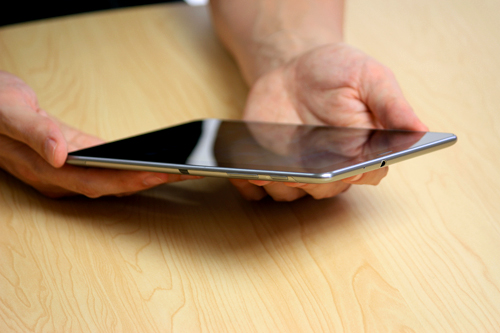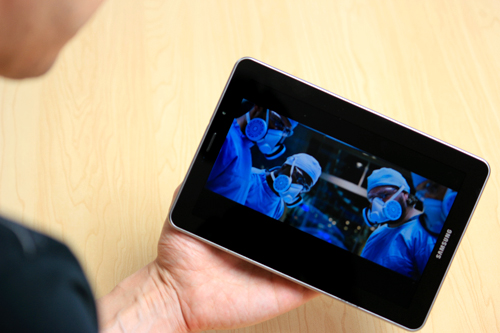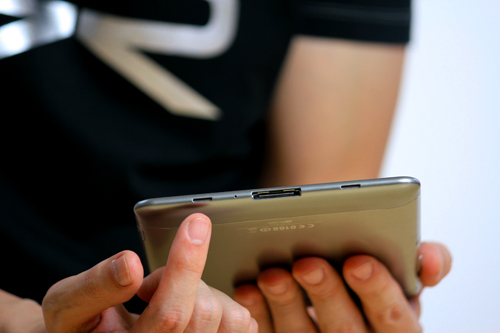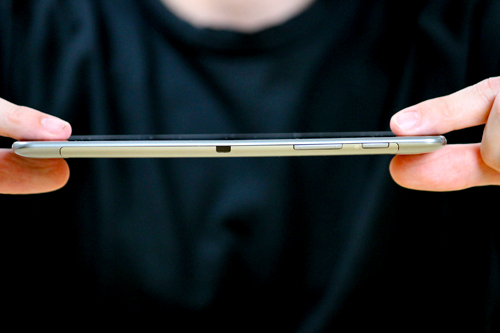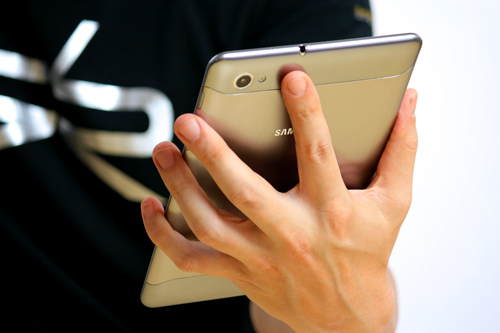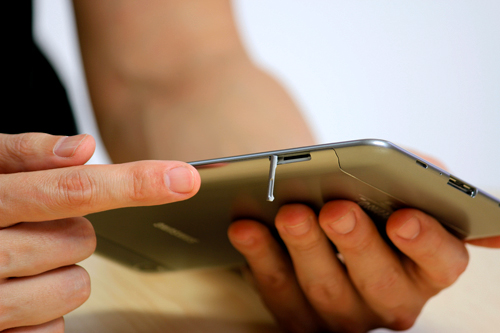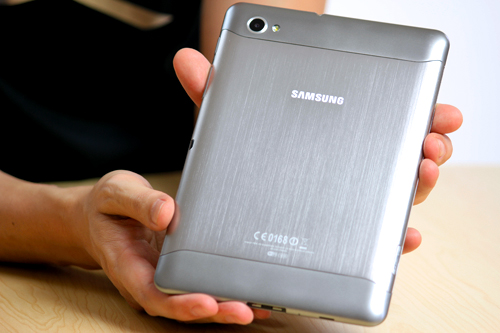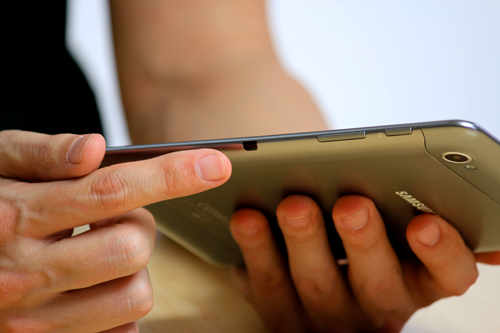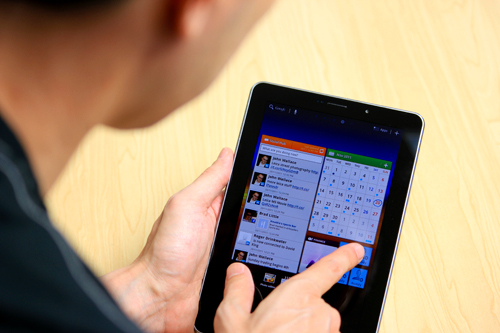
In a world where smartphone displays are getting more and more gargantuan, the 3.97-inch display on the Samsung Galaxy S Blaze 4G is refreshingly compact. Not everybody needs a 5.3-inch display on their phone (Galaxy Note, I'm looking at you!), and it's nice to see a more pocketable phone for those consumers. In addition, the Galaxy S Blaze 4G ($150 with a two-year contract on T-Mobile; price as of March 20, 2012) has fast data speeds (thanks to T-Mobile's HSPA+ 42 network) and smooth performance powered by a dual-core processor. But regrettably, the phone is riddled with carrier and manufacturer bloatware that you can't easily remove.

Design and Display
The Blaze has a fairly basic, Samsung-esque design with a glossy black face and rounded corners. The soft-touch, textured back gets fingerprint-greasy fast and seems to be a magnet for dust, crumbs, lint, and whatever else is in your pocket or bag. It's easy enough to clean, though. The Blaze looks a bit chunky, measuring 4.8 by 2.48 by 0.46 inches thick. It weighs a satisfactory 4.51 ounces.
The Blaze's 3.97-inch 480-by-800-pixel display is roomy enough for watching videos and playing games. Viewing angles are excellent on the Blaze's display, which uses Super AMOLED technology. Unfortunately, like other Super AMOLED displays we've encountered on Samsung phones, the Blaze's looked oversaturated in our color-bar and grayscale tests. In our color-bar test, the colors bled into each other; in the grayscale test, we had trouble differentiating the light-to-dark shades from one another. Still, oversaturation isn't always a bad thing: Colors looked rich and bright, and blacks were deep.
Software and Extras
Instead of the latest version of Android, Ice Cream Sandwich, the Blaze runs Android 2.3.6, (Gingerbread). Like other Samsung Galaxy phones (but not the Galaxy Nexus), it runs Samsung's TouchWiz user interface over Android.
Consumers (and reviewers) have a love/hate relationship with TouchWiz. On the one hand, it's relatively light and fast, and it adds some needed color to Android Gingerbread. On the other hand, the borderline cheesy, cartoony look of the user interface is a bit of a turn-off.
This phone comes with a ridiculous amount of carrier-and manufacturer-added software. From T-Mobile, you get 411, Game Base, More for Me, Netflix, Lookout T-Mobile TV, T-Mobile Name ID, T-Mobile Video Chat...and the list goes on. Sure, you might want some of these apps, like Netflix and Lookout, but the collection as a whole is unreasonably large. Some of the "apps" aren't even real; they're just links to app stores or trial versions of services. Samsung adds a few apps of its own; and again some--like Kies Air and AllShare--are useful, but others are merely pseudo-apps that require a separate download to get up and running. When you open the Samsung MediaHub, for example, a message informs you that you must install a separate app and create an account before you can run the app. Really?
One lovely thing about Android is the customization features and the bevy of apps available to you in Google Play. When carriers and manufacturers add all this junk to phones, they take some ownership away from the consumer. The phone you just bought with your hard-earned money doesn't feel like your phone--and that's unfair. Even worse, you can't remove many of these extra apps. On some Android phones, you can go into your settings and manually remove unwanted apps. But on the Galaxy S Blaze 4G, as far as I could tell, there is no such option for any of the added apps. Unless you root your phone, you're stuck with the bloatware.
Performance
The Galaxy S Blaze 4G is powered by a 1.5GHz dual-core Qualcomm Snapdragon processor with 1GB of RAM. We ran both Qualcomm's Vellamo benchmarking app as well as a third-party app, Quadrant. On Vellamo, the Galaxy S Blaze achieved an admirable score of 1071, putting it just below the Samsung Galaxy Nexus.
We take these scores with a grain of salt, as the Blaze has a Qualcomm processor and Vellamo is developed by Qualcomm. Oddly, on Quadrant, the Blaze scored better than the Galaxy Nexus. The true test of a phone's performance, in my opinion, is how well it handles the most heavy-duty apps and high-resolution video. I tested a handful of graphics-heavy games on the Blaze including Anomaly HD and Osmos HD. Both games ran flawlessly with the Super AMOLED display beautifully showcasing the 3D graphics.
The Galaxy S Blaze supports T-Mobile's faster HSPA+ network, which has theoretical speeds of up to 42 mbps. I tested the Galaxy S Blaze in various parts of San Francisco, using the FCC-approved Ookla Speedtest.net app, and achieved average download speeds of 6.77 mbps and upload speeds of 1.45 mbps. Signal strength varied around the city: Some areas produced speeds on par with Verizon's 4G LTE while other areas had more 3G-like speeds.
Call quality over T-Mobile was good, with ample volume and praiseworthy clarity on both my end and my contacts'. We haven't yet run battery testing for this model, but Samsung claims that the battery delivers 7 hours of talk time and 9 hours of standby. The Blaze 4G lasted for a full day (about 8 hours) of regular use before I needed to plug in again.
Camera
The Blaze's 5-megapixel camera took good pictures indoors and out. My outdoor pictures had bright, natural colors, though details were slightly fuzzy and I detected a bit of graininess (see the blue sky in the photo of the San Francisco Bay Bridge). My indoor photos had a little more graininess, but good colors. Details, such as the Furbies' fur, were lost, however. Still, for a 5-megapixel camera, it produced very satisfactory pictures. The TouchWiz camera interface is clean and easy to use, and it offers a few advanced controls such as white balance and exposure value, as well as some shooting effects (sepia, black-and-white, and others).
Bottom Line
The Galaxy S Blaze 4G has the performance and the specs of its Galaxy S II siblings but at a smaller size and a more affordable price. The bloatware is the phone's only real weakness, but the fact that users can't easily remove these carrier/manufacturer-added apps makes me hesitant to recommend the Blaze 4G enthusiastically.
If you're a fan of Samsung's Galaxy series and want the latest and greatest smartphone, you might want to hold out for a few months as the Samsung Galaxy S III is rumored to be launching soon. Another phone that might be worth waiting for is the HTC One S, which is headed to T-Mobile in the next month or two and has a 1.5GHz dual-core processor, a 4.3-inch qHD Super AMOLED display, and 16GB of internal memory. It's unclear whether it will be plagued with the same bloatware issue, however.





















